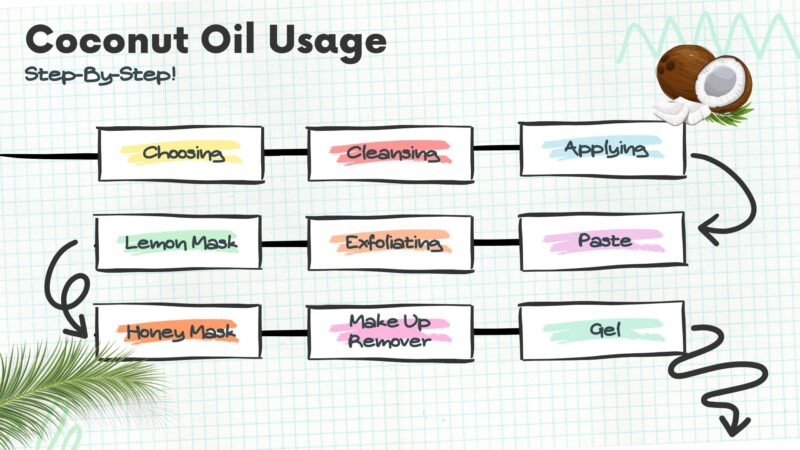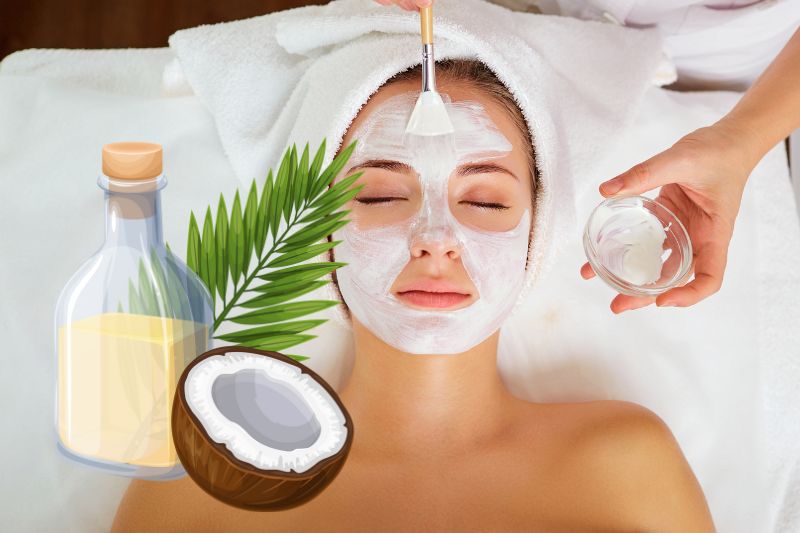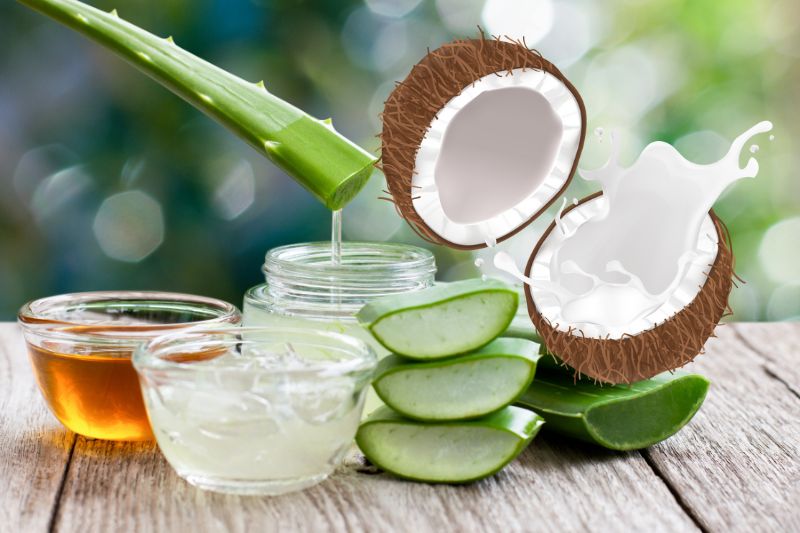Coconut oil is not just a kitchen staple; it’s a skincare powerhouse. Rich in fatty acids, particularly lauric acid, it offers excellent moisturizing properties that penetrate deeply into the skin. But what about its skin-lightening potential?
While coconut oil itself doesn’t bleach the skin, it can enhance the overall health and appearance of your skin, giving it a brighter, more even tone. When combined with other natural ingredients, coconut oil can help reduce dark spots, pigmentation, and dullness, giving your skin a more radiant glow.
The Science
Coconut oil is packed with antioxidants, which help combat free radicals—those pesky molecules that cause skin aging and dark spots. By fighting these free radicals, coconut oil helps maintain the skin’s youthful glow.
Moreover, coconut oil has mild exfoliating properties. When used correctly, it can help remove dead skin cells that accumulate on the skin’s surface, which is one of the main causes of dull and uneven skin tone.
In addition, coconut oil is known for its anti-inflammatory and antimicrobial properties. This means it can help soothe irritated skin, reduce redness, and prevent infections that may cause hyperpigmentation.
Our 9 Step Guide

Now that you understand why coconut oil is beneficial, let’s break down how you can use it to lighten your skin.
1. Choosing the Right Coconut Oil
First things first: not all coconut oils are created equal. For skincare, always opt for virgin coconut oil. This type of coconut oil is extracted from fresh coconuts without the use of chemicals or high temperatures, preserving all its natural goodness. It’s also less processed, which means it retains more antioxidants and beneficial compounds.
Avoid refined coconut oils as they may contain additives that are not suitable for skin application. Organic, cold-pressed virgin coconut oil is your best bet.
2. Cleansing Your Skin
Before applying coconut oil, make sure your skin is clean. Wash your face with a gentle cleanser to remove any dirt, makeup, or excess oil. Pat your skin dry with a soft towel, but leave it slightly damp. This allows the coconut oil to absorb more effectively.
3. Applying Coconut Oil Directly

The simplest way to use coconut oil for skin whitening is by applying it directly to your skin. Take a small amount of coconut oil (about a teaspoon) and warm it up in your hands. Massage it into your skin using gentle circular motions. Focus on areas with dark spots or pigmentation.
Let the oil sit on your skin for at least 30 minutes. For best results, you can leave it on overnight. Just be sure to use an old pillowcase as the oil may stain your bedding.
4. Coconut Oil and Lemon Juice Mask
For a more potent skin-lightening treatment, mix coconut oil with lemon juice. Lemon juice is a natural bleaching agent due to its high vitamin C content. When combined with coconut oil, it can help brighten your skin even more.
To make the mask, mix one tablespoon of coconut oil with half a teaspoon of freshly squeezed lemon juice. Apply the mixture to your skin, focusing on dark spots and areas with pigmentation. Leave it on for 15-20 minutes, then rinse off with lukewarm water. Remember, lemon juice can make your skin sensitive to sunlight, so it’s best to do this treatment in the evening and always wear sunscreen the next day.
5. Exfoliating with Coconut Oil and Baking Soda
Exfoliation is key to achieving brighter skin. By removing dead skin cells, you reveal the fresh, new skin underneath. Coconut oil paired with baking soda makes an excellent natural exfoliant.
Mix one tablespoon of coconut oil with one teaspoon of baking soda to create a paste. Gently massage this mixture onto your skin for about a minute, then rinse off with warm water. Use this scrub once or twice a week to maintain smooth, glowing skin.
6. Coconut Oil and Turmeric Paste

Turmeric is another natural ingredient known for its skin-brightening properties. It contains curcumin, which reduces excess melanin production and lightens dark spots. When combined with coconut oil, turmeric can help even out your skin tone.
Mix one tablespoon of coconut oil with a quarter teaspoon of turmeric powder. Apply the paste to your skin and leave it on for 10-15 minutes. Rinse off with lukewarm water, making sure to remove all traces of turmeric. This treatment can be done twice a week.
7. Coconut Oil and Honey Mask
Honey is a natural humectant, which means it helps retain moisture in the skin. It also has antibacterial properties, making it great for preventing acne and keeping the skin clear.
To make this mask, mix one tablespoon of coconut oil with one teaspoon of raw honey. Apply the mixture to your skin and leave it on for 20-30 minutes. Rinse off with warm water. This mask can be used two to three times a week for best results.
8. Coconut Oil as a Makeup Remover
Using coconut oil as a makeup remover can also contribute to a brighter complexion. Makeup residues can clog pores and lead to dull skin, but coconut oil effectively dissolves makeup while nourishing the skin.
Simply apply a small amount of coconut oil to a cotton pad and gently wipe away your makeup. Follow up with your regular cleansing routine to ensure your skin is thoroughly clean.
9. Coconut Oil and Aloe Vera Gel

Aloe vera is known for its soothing and healing properties. When combined with coconut oil, it can help lighten dark spots and give your skin a healthy glow.
Mix equal parts of coconut oil and aloe vera gel. Apply the mixture to your skin and leave it on for about 20 minutes before rinsing off with warm water. This treatment is especially beneficial for those with sensitive skin.
How Long Does It Take to See Results?
Patience is key when using natural remedies for skin whitening. Unlike chemical treatments, natural ingredients take time to show results. Consistency is crucial—use these treatments regularly, and you should start noticing a difference in your skin tone within a few weeks.
Remember that everyone’s skin is different, so results may vary. If you have sensitive skin, it’s always a good idea to do a patch test before trying out any new treatment.
Tips for Maximizing Results
To get the most out of your coconut oil treatments, consider these additional tips:
- Exfoliate regularly: Exfoliating helps remove dead skin cells, allowing the coconut oil to penetrate more deeply and work more effectively.
- Stay hydrated: Drinking plenty of water keeps your skin hydrated and helps flush out toxins that can cause dullness and dark spots.
- Use sunscreen: Coconut oil does not protect against UV rays, so always wear sunscreen during the day to prevent further pigmentation and sun damage.
- Eat a balanced diet: Your skin reflects what you eat. A diet rich in fruits, vegetables, and antioxidants can help maintain a healthy, glowing complexion.

